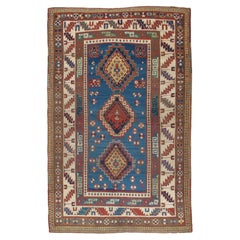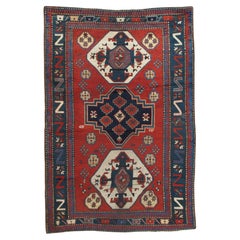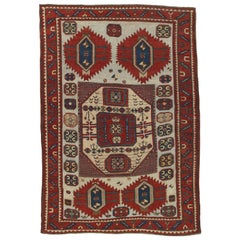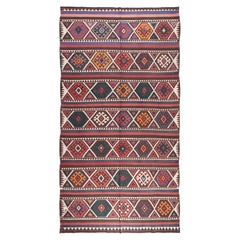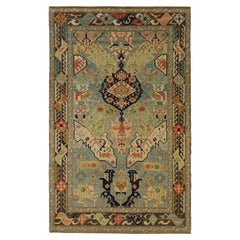Chaman Antique Rug Gallery Caucasian Rugs
to
3
Width
to
Length
to
3
3
3
3
3
3
3
3
3
3
3
3
Antique Kazak Carpet, Handmade Wool, Rust, Ivory, Navy, Light Blue and Gold
Located in Port Washington, NY
The Rust field scattered with minor stylized flower heads, hooked panels and minute cross-motifs around a column of ivory octagonal panels containing radiating flower heads and minut...
Category
Antique Late 19th Century Russian Kazak Caucasian Rugs
Materials
Wool
$11,999 Sale Price
20% Off
Antique Kazak Carpet, Handmade Wool, Rust, Ivory, Navy, Light Blue and Geometric
Located in Port Washington, NY
The Rust field scattered with minor stylized flower heads, hooked panels and minute cross-motifs around a column of ivory octagonal panels containing radiating flower heads and minut...
Category
Antique Late 19th Century Russian Kazak Caucasian Rugs
Materials
Wool
$11,999 Sale Price
25% Off
Antique Karachov Kazak Carpet, Handmade Wool, Pale Blue, Rust, Ivory, Geometric
Located in Port Washington, NY
Karachov Kazak: A quite famous and seldom-found design type, usually attributed to the Armenian weavers of the high Caucasus Mountains. The best of the ...
Category
Antique Late 19th Century Russian Kazak Caucasian Rugs
Materials
Wool
$12,000 Sale Price
20% Off
Related Items
Vintage Shirvan Kilim Rug, Handwoven Caucasian Old Carpet
Located in Tokyo, JP
This is an old Shirvan Kilim from the Caucasus region with a rare and beautiful color composition.
Of the four countries that make up the Caucasus, Azerbaijan produces the most kilims, and the land has a long history of weaving. The nomadic tribes wove kilims and carpets as well as a wide range of storage bags and sacks, such as saffrash, khurgin and chula, and donkey and horse trappings. Smaller bags...
Category
Late 20th Century Caucasian Kilim Caucasian Rugs
Materials
Natural Fiber, Wool
Ararat Rugs Dragon Rug, Antique Caucasus Museum Revival Carpet, Natural Dyed
By Ararat Rugs
Located in Tokyo, JP
There has long been a fascination with the symbolism of the dragon and its depiction in carpet weavings. The design of ‘Dragon’ carpets consists of a field pattern composed of different colored overlaid lattices formed of pointed, serrated leaves creating intersecting lozenges, which alternately contain palmettes and are flanked by confronting stylized dragons, birds, or animal figures. The most archaic of the ‘Dragon’ carpets include dragon motifs with birds and running animals relatively naturalistically drawn, which stand either alone or in confronting pairs facing a tree. The Graf carpet, originally found in a Damascene mosque, now in the Islamiches Museum, Berlin, is considered to be the oldest example of this type, see Serare Yetkin, Early Caucasian Carpets in Turkey, Vol. II, London, 1978, p.8, fig.118. Yetkin defines four types of ‘Dragon’ carpet: ‘Archaic’, ‘Four-Dragon’, ‘Dragon-and-Phoenix’ and as a further combined development of the latter, the ‘Two-Dragon’ style, of which the present carpet falls into the ‘Dragon-and-Phoenix group along with other examples, some of which include two fragments, one in the Museum fur Kunst und Gerwerbe, Hamburg; another in the Christian Museum, Esztergom, Hungary, a complete carpet in the Kier collection; an incomplete example in the Textile Museum, Washington, D.C; the ‘Cassirer’ Dragon carpet in the Thyssen-Bornemisza collection, Lugano; the Ali Pasa Mosque carpet in Tokat, and a further example in the Vakiflar Hali Museum, Istanbul (S. Yetkin, op. cit. pp.16-20). It has been suggested that the earliest examples of the Caucasian ‘Dragon’ carpets...
Category
21st Century and Contemporary Caucasian Revival Caucasian Rugs
Materials
Organic Material, Natural Fiber, Wool
$8,500
W 67.33 in L 106.7 in
Antique Rugs Blue Caucasian Kazak Rugs, Geometric Carpet Livingroom Rug
Located in Wembley, GB
Kazak rugs have primarily been produced as village productions rather than city pieces. Made from materials particular to individual tribal provinces and the rugs of the Caucasus typically display bold geometric designs in primary colours. Kazak rugs are a type of Armenian rug...
Category
Antique Late 19th Century Caucasian Kazak Caucasian Rugs
Materials
Wool, Natural Fiber, Organic Material
Ararat Rugs Akstafa Kazak Rug - 19th C. Caucasian Revival Carpet Natural Dyed
By Ararat Rugs
Located in Tokyo, JP
Origin and Inspiration:
This stunning revival of the Akstafa Kazak Rug is a modern creation deeply rooted in the rich weaving traditions of the Caucasus, specifically inspired by the...
Category
21st Century and Contemporary Turkish Revival Caucasian Rugs
Materials
Wool, Natural Fiber, Organic Material
$4,200
W 44.1 in L 72.45 in
Antique Caucasus Soumak Kilim Sumac Rug, Caucasian Sumak Natural Carpet
Located in Tokyo, JP
This is an Antique Soumak ( Sumak, Sumac ) Kilim from the Caucasus region with a rare and beautiful color composition.
Of the four countries that make up the Caucasus, Azerbaijan produces the most kilims, and the land has a long history of weaving. The nomadic tribes wove kilims and carpets as well as a wide range of storage bags and sacks, such as saffrash, khurgin and chula, and donkey and horse trappings. Smaller bags for salt, utensils, and other items are also common. Not only are the Azerbaijani weavers prolific, but they also employ many techniques at the loom. These include slitweave- known locally by the word Kilim, warp-faced patterning (jajim), supplementary weft (zili), weft wrapping (popularly known as soumak), and extra weft wrapping (verneh). Furthermore, flatweaves are defined by regional names such as palas and shadda, so it is possible to ascribe a variety of weaving names to particular provenances as follows: soumaks are made in Kuba, palas, and kilims in Hajikabul, zili in Khizy, verneh and zili in Kazakh, shadda, verneh and zili in Barda, jajim in Agjabedi, and palas and kilims in Jabrail.
Soumak weave is a technique in which weft threads are added to a plain weave fabric, and one or two warp threads are wound from the front to the back. The resulting Kilim is denser and firmer, giving it a unique feel and look. This technique is commonly used in the Caucasus region.
Soumak kilims have a very beautiful contrast between orange that shines like the sun, deep purple-tinged indigo, and astringent dark red. You can also see the unevenly dyed abrage in this Soumak, which is like a magic carpet with an oriental atmosphere. Features of the Caucasian Kilim, such as the unique cosmic geometric floral pattern, are also found in this Soumak which has a bright look, but it also has a faded and textured feel, so it can be used in a good old atmosphere.
The woven fabric is particularly solid, so it is recommended for use in a solid living room or under a dining table without moving or twisting. A nice Kilim under a long wooden dining table.
Category
Antique Late 19th Century Caucasian Kilim Caucasian Rugs
Materials
Wool, Natural Fiber
Caucasus Kuba Fine Kilim Vintage Old Rug, Caucasian Natural Carpet
Located in Tokyo, JP
This is a Caucasian Old Kilim from the Kuba region with a red background and beautiful color composition.
Kilim of Kuba, a city in Azerbaijan. It is located by the Caspian Sea, ne...
Category
Mid-20th Century Caucasian Kilim Caucasian Rugs
Materials
Natural Fiber, Wool
Ararat Rugs Dragon Rug, Antique Caucasus Museum Revival Carpet, Natural Dyed
By Ararat Rugs
Located in Tokyo, JP
There has long been a fascination with the symbolism of the dragon and its depiction in carpet weavings. The design of ‘Dragon’ carpets consists of a field pattern composed of differ...
Category
21st Century and Contemporary Caucasian Oushak Caucasian Rugs
Materials
Wool, Natural Fiber, Organic Material
$9,300
W 67.72 in L 111.42 in
Antique Caucasian Runner Rug, Caucasus Carpet
Located in Tokyo, JP
This is an antique runner rug from the Caucasus region with a rare and beautiful color composition.
Of all the rugs of the oriental world, it is the work of the Caucasian weavers ...
Category
Early 20th Century Caucasian Oushak Caucasian Rugs
Materials
Wool, Natural Fiber
Antique Caucasus Verneh Kilim Rug, Caucasian Natural Carpet
Located in Tokyo, JP
This is a large Antique Verneh Kilim from the Caucasus region with a rare and beautiful color composition.
Of the four countries that make up the Caucasus, Azerbaijan produces the most kilims, and the land has a long history of weaving. The nomadic tribes wove kilims and carpets as well as a wide range of storage bags and sacks, such as saffrash, khurgin and chula, and donkey and horse trappings. Smaller bags...
Category
Early 20th Century Caucasian Kilim Caucasian Rugs
Materials
Natural Fiber, Wool
Antique Caucasus Soumak Kilim Sumac Rug, Caucasian Natural Carpet
Located in Tokyo, JP
This is a large Antique Soumak ( Sumak, Sumac ) Kilim from the Caucasus region with a rare and beautiful color composition.
Of the four countries that make up the Caucasus, Azerbaijan produces the most kilims, and the land has a long history of weaving. The nomadic tribes wove kilims and carpets as well as a wide range of storage bags and sacks, such as saffrash, khurgin and chula, and donkey and horse trappings. Smaller bags for salt, utensils, and other items are also common. Not only are the Azerbaijani weavers prolific, but they also employ many techniques at the loom. These include slitweave- known locally by the word kilim, warp-faced patterning (jajim), supplementary weft (zili), weft wrapping (popularly known as soumak), and extra weft wrapping (verneh). Furthermore, flatweaves are defined by regional names such as palas and shadda, so it is possible to ascribe a variety of weaving names to particular provenances as follows: soumaks are made in Kuba, palas, and kilims in Hajikabul, zili in Khizy, verneh and zili in Kazakh, shadda, verneh and zili in Barda, jajim in Agjabedi, and palas and kilims in Jabrail.
Soumak weave is a technique in which new weft threads are added to a plain weave fabric, and one or two warp threads are wound from the front to the back. The resulting kilim is denser and firmer, giving it a unique feel and look. This technique is commonly used in the Caucasus region.
Soumak Kilims have a very beautiful contrast between orange that shines like the sun, deep purple-tinged indigo, and astringent dark red. You can also see the unevenly dyed abrage in this sumac, which is like a magic carpet with an oriental atmosphere.
Features of the Caucasian kilim, such as the unique cosmic geometric floral pattern, are also found in this Soumak. It has a bright look, but it also has a faded and textured feel, so it can be used in a good old atmosphere. The woven fabric is particularly solid, so it is recommended for use in a solid living room or under a dining table without moving or twisting. A nice kilim under a long wooden dining table.
Category
Early 20th Century Caucasian Kilim Caucasian Rugs
Materials
Wool, Natural Fiber
Antique Karachov Kazak Rug Karachoph Southwest Caucasus Carpet Late-19th Century
Located in Tokyo, JP
This is an antique Karachov Kazak Rug from the Karachov / Karachoph region, Southwest Caucasus.
The town of Karachov (sometimes rendered Karatchoph o...
Category
Antique Late 19th Century Caucasian Oushak Caucasian Rugs
Materials
Wool, Natural Fiber, Organic Material
$12,000
W 66.93 in L 84.26 in
Ararat Rugs Derbend Kazak Rug, 19th C. Caucasian Revival Carpet Natural Dyed
By Ararat Rugs
Located in Tokyo, JP
This is a Derbend Kazak rug also known as Daghestan rug, designed late 19th century, is a type of handwoven rug that originates from the Caucasus region, specifically from the town of Derbend (also spelled as Derbent) in modern-day Dagestan, Russia. Derbend rugs have a rich history that dates back centuries and are highly regarded for their intricate designs and craftsmanship. Derbend rugs are known for their bold and vibrant geometric designs. They often feature intricate patterns and motifs such as diamonds, medallions, stars, and stylized floral elements. The designs are typically woven with high contrast, using a variety of colors, including red, blue, green, and ivory. Derbend rugs have been woven by various ethnic groups in the Caucasus region, including the Azerbaijani, Lezgian, and Avar peoples. They hold cultural and historical importance as a form of artistic expression and are considered a part of the region's rich weaving heritage. The design of this rug is interpreted by our designers and soft colors are chosen for this rug.
Color summary: 7 colors in total;
Turquoise 330 (Spurge - Madder Root - Indigo - Walnut Husk)
Dark Brown 316 (No Dye - Sheep’s Own Color)
Barley Corn 103 (Only Specially Washed)
Mandarian Orange 529 (Madder Root - Walnut Hulsk)
Wax Flower...
Category
21st Century and Contemporary Caucasian Revival Caucasian Rugs
Materials
Wool, Natural Fiber, Organic Material
$2,970
W 51.97 in L 75.6 in
